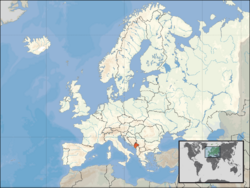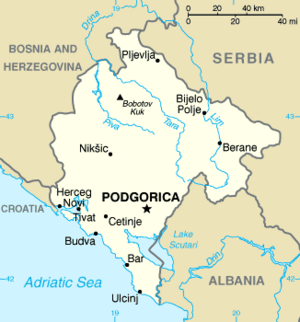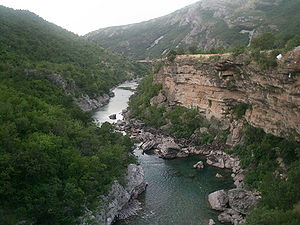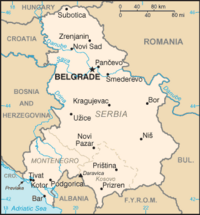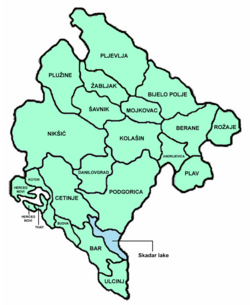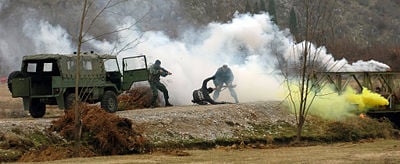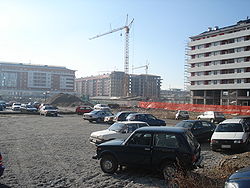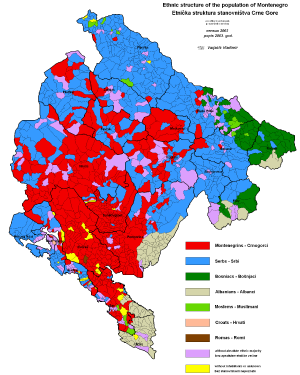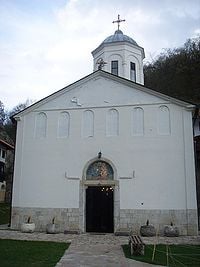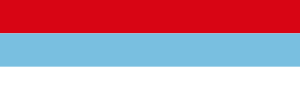Montenegro
| Република Црна Гора Republika Crna Gora Republic of Montenegro | |||||
| |||||
| Anthem: Oj, svijetla majska zoro "Oh, Bright Dawn of May" | |||||
| Capital | Podgorica 42°47′N 19°28′E | ||||
|---|---|---|---|---|---|
| Largest city | capital | ||||
| Official languages | Serbian (Ijekavian dialect)1 | ||||
| Government | Republic | ||||
| - President | Filip Vujanović | ||||
| - Prime Minister | Željko Šturanović | ||||
| Independence | due to the dissolution of Serbia and Montenegro | ||||
| - Declared | June 3, 2006 | ||||
| - Recognized | June 8, 2006 | ||||
| Area | |||||
| - Total | 13,812 km² (159th) 5,019 sq mi | ||||
| - Water (%) | 1.5 | ||||
| Population | |||||
| - July 2007 estimate | 684,736[1] | ||||
| - 2003 census | 620,145 | ||||
| - Density | 44.9/km² 115.6/sq mi | ||||
| GDP (PPP) | 2005 estimate | ||||
| - Total | $11,458 billion | ||||
| - Per capita | $3,800 | ||||
| HDI (2004) | 0.788[2] (medium) | ||||
| Currency | Euro2 (EUR)
| ||||
| Time zone | CET (UTC+1) | ||||
| - Summer (DST) | CEST (UTC+2) | ||||
| Internet TLD | .yu (.me)3 | ||||
| Calling code | +382 | ||||
| 1 The current DPS-SDP regime calls it Montenegrin language, introducing the term to official usage since last year. Albanian is co-official in the municipality of Ulcinj. 2 Adopted unilaterally; Montenegro is not a formal member of the Eurozone. 3 .me should come into use in 2007, while .yu is a holdover from Serbia and Montenegro which is still in use for Montenegrin subdomains [1]. | |||||
Montenegro (Serbian: Црна Гора or Crna Gora, officially The Republic of Montenegro (Serbian: Црна Гора, Crna Gora, meaning "black mountain") is a small, mountainous state in south-west Balkans, bordering Croatia, Bosnia and Herzegovina, Serbia, Albania and the Adriatic Sea.
De facto independent since the late Middle Ages, and an internationally recognised country from 1878 until 1918, Montenegro was later a part of various incarnations of Yugoslavia and the state union of Serbia and Montenegro.
Based on the results of the referendum held on May 21, 2006, Montenegro declared independence on June 3, 2006, and on June 28, 2006, it became the 192nd member state of the United Nations, and on May 11, 2007, the 47th member state of the Council of Europe.
Geography
With a land area 5019 square miles (13,812 square kilometers), Montenegro is slightly smaller than Connecticut. Montenegro ranges from high peaks along its borders with Serbia and Albania, a segment of the Karst of the western Balkan Peninsula, to a narrow coastal plain that is only one to four miles wide. The plain stops abruptly in the north, where Mount Lovćen and Mount Orjen plunge abruptly into the inlet of the Bay of Kotor.
Montenegro's large Karst region lies generally at elevations of 3281 feet (1000 meters) above sea level. Some parts rise to 6560 feet (2000 meters), such as Mount Orjen at 6214 feet (1894 meters), the highest massif among the coastal limestone ranges. The Zeta River valley, at an elevation of 1640 feet (500 meters), is the lowest segment.
The mountains of Montenegro include some of the most rugged terrain in Europe. They average more than 6560 feet (2000 meters) in elevation. One of the country's notable peaks is Bobotov Kuk in the Durmitor mountains, which reaches a height of 8274 feet (2522 meters). The Montenegrin mountain ranges were among the most ice-eroded parts of the Balkan Peninsula during the last glacial period.
Natural resources include bauxite and hydroelectricity.
Lower areas have a Mediterranean climate, with dry summers and mild, rainy winters. Temperature varies with elevation. Podgorica, near sea level, has the warmest July (summer) temperatures, averaging 81°F (27°C). Cetinje, in the Karst region at 2200 feet (670m), has an average temperature that is 10°F (5°C) lower. Average January (winter) temperatures at Bar on the southern coast are 46°F (8°C). Annual precipitation at Crkvice, in the Karst, is nearly 200 inches (5100 mm), during the cold part of the year. Snow cover is rare along the Montenegrin coast, increasing to 120 days in the higher mountains.
Runoff in the north enters the Lim and Tara rivers, which flow into the Drina River, which forms the border between Bosnia and Herzegovina and Serbia. In the south, streams flow toward the Adriatic. Drainage of the karst region travels in underground channels. Lake Scutari (Skadarsko Jezero), at 25 miles (40km) long and 10 miles (16km) wide, is the country's largest lake and extends into northern Albania. The mountains are noted for numerous smaller lakes.
One-third of Montenegro, mainly the high mountains, remains covered with broad-leaved forest. The southern Karst zone, lacking soils, remained forested through classical times, with oaks and cypresses predominating. Removal of forests for domestic fuel and construction led to soil erosion and ultimately, to regeneration in Mediterranean scrub known as maquis.
Sparsely populated Montenegro has numerous mammals, including bears, deer, martens, and wild pigs, as well as predatory wild animals, including wolves, foxes, and wildcats, along with a rich variety of birds, reptiles, and fish.
Destructive earthquakes are the main natural hazard. Environmental issues relate to the pollution of coastal waters from sewage outlets, especially in tourist-related areas such as Kotor
Its de facto capital and largest city is Podgorica, with a population in 2003 of 169,299. The favorable geographical position at the confluence of the Ribnica and Morača rivers, on the meeting point of fertile Zeta plain and Bjelopavlići Valley has made the city an attractive location for settlement. The city is situated only a few dozen kilometers from both winter ski centers in the north and seaside resorts on Adriatic Sea. The municipality of Podgorica accounts for 10.4 percent of Montenegro's territory and 27.3 percent of its population. Besides being an administrative center of Montenegro, Podgorica is also its economic, cultural and educational focal point.
Cetinje (population 20,307) is designated as Prijestonica, the old royal capital or seat of the throne. Other cities and towns include Nikšić (104,706), Pljevlja (44,593), Bijelo Polje (55,628), Herceg Novi (30,593, including Igalo), and Berane (49,953).
History
Template:History of Montenegro
The first settlers of Montenegro were the Illyrians.
Romans conquered these southern Illyrians in AD 9, annexing them to the Roman province of Illyricum. The historian Theodore Mommsen wrote (in his The Provinces of the Roman Empire) that all Illyricum was fully Romanised and Latin speaking by the fourth century.
The division of the Roman Empire between Roman and Byzantine rule – and subsequently between the Latin and Greek churches – was marked by a line that ran northward from Skadar through modern Montenegro, symbolizing the status of this region as a perpetual marginal zone between the economic, cultural, and political worlds of the Mediterranean peoples and the Slavs. As Roman power declined in the fifth century, this part of the Adriatic coast suffered from intermittent ravages by various semi-nomadic invaders, especially the Goths in the late fifth century and the Avars during the sixth century. These soon were supplanted by the Slavs, who became widely established in the Balkans by the middle of the seventh century.
The Romanized Illyrians escaped to the mountains and survived mainly as shepherds, and were named morlachs (dark "vlachs"), and eventually losing their original Romance language by being assimilated with the Slavs. This extinct neo-Latin language can be found in the toponimy of many places of Montenegro, like the name of the mount Durmitor, that means "place where to sleep" in the language of those Vlachs.The last morlachs, called Vlasi Ridani, moved from Durmitor area in the 15th century, escaping the Ottoman conquest, and found refuge in Dalmatia and Istria.
Slav tribes, mixed with the descendants of the romanized Illyrians, formed the semi-independent dukedom of Duklja by the tenth century. In 1077, Pope Gregory VII recognized Duklja as an independent state, acknowledging its King Mihailo (Michael) (of the Vojislavljević dynasty founded by nobleman Stefan Vojislav) as rex Docleae (King of Duklja).[3][4] The kingdom, however, paid tribute to the Byzantine Empire and later to the Bulgarian Empire; it gave birth to the medieval kingdom of the Serbian Grand Prince (Serbian: župan) Stefan Nemanja, who was born in Ribnica, a settlement near Doclea, renaming the country "Zeta".
The Principality of Zeta asserted its independence in the 1360s.[5][6]The House of Balšić (1360s–1421) and the House of Crnojević (1421–1499) ruled Zeta. Although the Ottoman Empire controlled the lands to the south and east from the 15th century, it never fully conquered Zeta.[citation needed]
Most of the coast of Montenegro was controlled by the Republic of Venice from the 13th century to the Napoleon times(1420-1797) although Bar and Ulcinj were conquered by the Ottomans in the 1570s. The area was called Albania Veneta.
During those centuries the Venetian language, from which the word "Montenegro" comes, was the lingua franca of the Adriatic coast of Montenegro. In the area of Bay of Kotor there were Venetian speaking populations until the first half of the 20th century. For example, in the Austrian census of 1880, Kotor had 930 ethnic Italians in a total population of 2910 people.
In 1516, the secular prince Đurađ Crnojević abdicated in favour of Archbishop Vavil, who then made Montenegro into a theocratic state[7] under the rule of the prince-bishop (known as владика, vladika) of Cetinje, a position held from 1697 by the Petrović-Njegoš family of the Riđani clan. Petar Petrović Njegoš, perhaps the most influential vladika, reigned in the first half of the 19th century. In 1851, Danilo II Petrović Njegoš became vladika, but in 1852 he married, left the priesthood, assumed the title of knjaz (Prince), and transformed his land into a secular principality. Montenegro officially confirmed its independence and became a principality in 1878. Later, it was transformed into a kingdom in 1910, under the rule of King Nicholas I. [8][9]
In 1910, Prince Nicholas I became King of Montenegro. Two years later, in October 1912, King Nicholas declared war on the Ottoman Empire, preceding the two Balkan Wars. The Montenegrin army attacked the Ottoman fortress city of Shkodër, and forced the empire to gather a large army in neighbouring Macedonia. This Ottoman army was then attacked by the forces of Greece, Serbia, and Bulgaria which entered the war by pre-arrangement. This resulted in the redefinition of borders in the Balkans according to the Treaty of London in 1913.
Montenegro emerged from the Balkan Wars doubled in size, receiving half of the former Ottoman territory known as Sandžak, but without the city of Shkodër, the country's major goal in the war. The London Conference awarded Shkodër to an independent country of Albania.
During World War I, Montenegro was part of the allies. In the Battle of Mojkovac. Montenegro's army bravely defended the fallback for Serbian troops withdrawing across Albania. In the course of the war, Montenegro was occupied by Austro-Hungarian troops. Feldmarschalleutnant Viktor Weber von Webenau became Military Governor of Montenegro on February 26 1916.
In 1918, the Podgorica Assembly, whose legality is questioned up to the present, voted for uniting Montenegro with the Kingdom of Serbia. [10][11] However, pro-independence Montenegrins revolted on Christmas Day 1919 (January 7, 1919, Christmas Day by the then-prevailing Orthodox calendar) against Serbia.[12] The revolt was finally suppressed in 1924, although guerrilla resistance remained in the Highlands for many years after.
During WWII Italy occupied Montenegro in 1941 and annexed the area of Kotor[13], where there was a small Roman population (also, the Queen of Italy, Elena of Montenegro, was daughter of the former king of Montenegro), to the Kingdom of Italy. The Independent State of Montenegro was created under fascist control when Krsto Zrnov Popović returned from exile in Rome in 1941 to attempt to lead the Zelenaši ("Green" party), who supported the reinstatement of the independent Montenegrin monarchy. These forces were called the Lovćen Brigade. Montenegro was ravaged by a terrible guerrilla war, mainly after Nazi Germany replaced the defeated Italians in September 1943.
After World War II, from 1945 to 1992, Montenegro became a constituent republic of the Socialist Federal Republic of Yugoslavia in its own right. It was during this time that the present capital Podgorica was renamed Titograd, after Josip Broz Tito, communist ruler of Yugoslavia. Over the next half century, Montenegro remained one of six constituent republics of Yugoslavia.
Union with Serbia (1992–2006)
After the dissolution of the Socialist Federal Republic of Yugoslavia in 1992, Montenegro agreed on a federation with Serbia, first as the Federal Republic of Yugoslavia, then as a looser State Union of Serbia and Montenegro that broke up as soon as a deadline for holding an independence referendum expired.
In the referendum on remaining in Yugoslavia in 1992, 95.96% of the votes were cast for remaining in the federation with Serbia, although the turnout was at 66% because of a boycott by the Muslim, Albanian and Catholic minorities as well as of pro-independence Montenegrins. The opposition claimed that poll was organised under undemocratic conditions, during war time in the former Yugoslavia, with widespread propaganda from the state-controlled media in favour of a pro-federation vote. There is no impartial report on the fairness of the referendum, as the 1992 referendum was totally unmonitored, unlike the 2006 vote, which has been closely monitored by the European Union.
During the recent Bosnian War and Croatian War (1991-1995) Montenegro participated with its police and paramilitary forces in the attacks on Dubrovnik and Bosnian towns along with Serbian troops. It conducted persecutions against Bosniak refugees who were arrested by Montenegrin police and transported to Serb camps in Foča, where they were executed.[14]
In 1996, Milo Đukanović's government de facto severed ties between Montenegro and Serbia, which was then still under Milošević. Montenegro formed its own economic policy and adopted the Deutsche Mark as its currency. It has since adopted the euro, though it is not formally part of the Eurozone. Subsequent governments of Montenegro carried out pro-independence policies, originally restored by the Liberal Alliance of Montenegro, and political tensions with Serbia simmered despite the political changes in Belgrade. Despite its pro-independence leanings, targets in Montenegro were repeatedly bombed by NATO forces during Operation Allied Force in 1999.[15]
In 2002, Serbia and Montenegro came to a new agreement regarding continued cooperation. The Public International Law & Policy Group (PILPG) provided legal counsel to Montenegro during its negotiations with Serbia over the future status of the Federal Republic of Yugoslavia. In 2003, the Yugoslav federation was replaced in favor of a looser state union named Serbia and Montenegro and a possible referendum on Montenegrin independence was postponed for a minimum of three years.
21st century independence
The status of the union between Montenegro and Serbia was decided by the referendum on Montenegrin independence on May 21, 2006. A total of 419,240 votes were cast, representing 86.5% of the total electorate. 230,661 votes or 55.5% were for independence and 185,002 votes or 44.5% were against.[16] The 45,659 difference narrowly surpassed the 55% threshold needed to validate the referendum under the rules set by the European Union. According to the electoral commission, the 55% threshold was passed by only 2,300 votes. Serbia, the member-states of the European Union, and the permanent members of the United Nations Security Council have all recognized Montenegro's independence; by doing so they removed all remaining obstacles from Montenegro's path towards becoming the world's newest sovereign state.
The 2006 referendum was monitored by five international observer missions, headed by an OSCE/ODIHR monitoring team, and around 3,000 observers in total (including domestic observers from CEMI, CEDEM and other organizations). The OSCE/ODIHR ROM joined efforts with the observers of the OSCE Parliamentary Assembly (OSCE PA), the Parliamentary Assembly of the Council of Europe (PACE), the Congress of Local and Regional Authorities of the Council of Europe (CLRAE) and the European Parliament (EP) to form an International Referendum Observation Mission (IROM). The IROM—in its preliminary report—"assessed compliance of the referendum process with OSCE commitments, Council of Europe commitments, other international standards for democratic electoral processes, and domestic legislation." Furthermore, the report assessed that the competitive pre-referendum environment was marked by an active and generally peaceful campaign and that "there were no reports of restrictions on fundamental civil and political rights."
On June 3 2006, the Parliament of Montenegro declared the independence of Montenegro[17], formally confirming the result of the referendum on independence. Serbia did not obstruct the ruling, confirming its own independence and declaring the Union of Serbia and Montenegro ended shortly thereafter.
On September 6 2007 an advisor of the Prime Minister of Serbia called Montenegro a 'quasi-state'[18]. Montenegro gave a protest list to the Serbian Ministry for Foreign Affairs. The Deputy Prime Minister of Serbia, Božidar Đelić, has apologised for this. [19]
International recognition of Montenegro
The first state to recognize Montenegro was Icelandon June 8, 2006, followed by Switzerland[20] and Estonia[21] on June 9, and Russia on June 11 Croatia recognises Montenegrin independence], Bosnia and Herzegovina and Slovenia and the United States recognized Montenegro on June 12, as did various member states of the EU and other European countries. The United Kingdom formally extended recognition on June 13as did the People's Republic of China and France on June 14, meaning that all five permanent United Nations Security Council members then recognized the independence of Montenegro. Serbia, the other former constituent member of the State Union, recognized Montenegro on June 15signaling the formal dissolution of the Union. The Organization for Security and Co-operation in Europe decided to accept Montenegro as the 56th member of the organization on June 21 and the country took its seat at the Permanent Council on June 22. The United Nations, in a vote of the Security Council, extended full membership in the organization to Montenegro on June 22, 2006. Montenegro was confirmed as a member on June 28. In January 2007, Montenegro received full membership in the International Monetary Fund and the World Bank Group. It was admitted to the Council of Europe on May 11 the same year.
Government and politics
Montenegro is a parliamentary representative democratic republic that gained full independence from Serbia in June 2006, following a referendum in May. Montenegro is governed by independent executive, legislative, and judicial branches. The president is the head of state, elected directly for a period of five years, and is eligible for a second term. The unicameral national assembly has 81 members elected by direct vote for four-year terms, and is led by a prime minister, who is proposed by president and accepted by the assembly. Ministries act as cabinet.
In the 2006 elections, the Coalition for European Montenegro took 40.6 percent of the vote, Serbian List 15.3 percent, Coalition SNP-NS-DSS 14.8 percent, PZP 13.9 percent, Liberals and Bosniaks 3.8 percent, other (including Albanian minority parties) 11.6 percent. Suffrage is universal to those aged 18 years of age and over.
Montenegro's judicial branch includes a constitutional court composed of five judges with nine-year terms and a supreme court with justices that have life terms.
Montenegro is divided into 21 municipalities (opština), and two urban municipalities, subdivisions of Podgorica municipality: Andrijevica, Bar, Berane, Bijelo Polje, Budva, Cetinje, Danilovgrad, Herceg Novi, Kolašin, Kotor, Mojkovac, Nikšić, Plav, Plužine, Pljevlja, Podgorica, Golubovci, Tuzi, Rožaje, Šavnik, Ulcinj, and Žabljak.
Montenegro inherited a 6500-strong military force from the previous combined armed forces of Serbia and Montenegro. It has announced plans to reduce the number of active personnel to around 2500. This force will consist entirely of volunteers. Conscription was abolished in August 2006 by decision of Montenegro's president, Filip Vujanović. A naval force will be retained, but reduced to a force closer in size and capacity to a coast guard.
Economy
The first factories were built in Montenegro in the first decade of the twentieth century, followed by wood mills, an oil refinery, a brewery, and electric power plants. During the communist era, Montenegro underwent a rapid period of urbanization and industrialization. An industrial sector based on electricity generation, steel, aluminum, coal mining, forestry and wood processing, textiles and tobacco manufacture was developed, while trade, international shipping, and particularly tourism became increasingly important by the late 1980s.
During the era of communism Montenegro experienced a rapid period of urbanization and industrialization. An industrial sector based on electricity generation, steel, aluminum, coal mining, forestry and wood processing, textiles and tobacco manufacture was built up, with trade, overseas shipping, and particularly tourism, increasingly important by the late 1980s.
The loss of previously guaranteed markets and suppliers after the break-up of Yugoslavia left the Montenegrin industrial sector reeling as production was suspended and the privatization program, begun in 1989, was interrupted. The disintegration of the Yugoslav market, and the imposition of the UN sanctions in May 1992 were the causes of the greatest economic and financial crisis since World War II. During 1993, two thirds of the Montenegrin population lived below the poverty line, while frequent interruptions in relief supplies caused the health and environmental protection to drop below the minimum of international standards.
The financial losses under the adverse effects of the UN sanctions on the overall economy of Montenegro are estimated to be approximately $6.39-billion. This period also experienced the second highest hyperinflation in history (three million percent in January 1994) (The highest hyperinflation happened in Hungary after the end of World War II, when inflation there hit 4.19 x 1016 percent).
In 1997, Milo Đukanović took control over the ruling Democratic Party of Socialists of Montenegro (DPS) and began severing ties with Milosevic' Serbia. He blamed the policies of Slobodan Milošević for the overall decline of the Montenegrin economy, as well as Milošević's systematic persecution of non-Serbs. Montenegro introduced the German mark as response to again-growing inflation, and insisted on taking more control over its economic fate. This eventually resulted in creation of Serbia and Montenegro, a loose union in which Montenegro mostly took responsibility for its economic policies.
This was followed by implementation of faster and more efficient privatization, passing of reform laws, introduction of VAT and usage of euro as Montenegro's legal tender.
Agricultural produce includes (organic) foods, particularly meat (poultry, lamb, goat, veal/beef); milk and dairy produce; honey; fish; vegetables (tomato, pepper, cucumber, and other); fruits (plum, apple, grapes, citrus fruits, olive); high quality wines (Vranac, Krstac, and others); as well as naturally pure potable water.
Exports totalled $171.3 million (2003) Export commodities included Export partners included Switzerland 83.9%, Italy 6.1%, Bosnia and Herzegovina 1.3% (2006). Imports totalled $601.7 million (2003) Import commodities included Import partners included Greece 10.2%, Italy 10.2%, Germany 9.6%, Bosnia and Herzegovina 9.2% (2006)
Severe unemployment (27.7 percent in 2005) remains a key political and economic problem. Montenegro has privatized its large aluminum complex - the dominant industry - as well as most of its financial sector, and has begun to attract foreign direct investment in the tourism sector. GDP per capita (purchasing power parity) was $3800 in 2005, a rank of 150. About 12.2 percent of the population existed below the poverty line in 2003.
Demographics
Population
According to 2003 census, Montenegro has 620,145 citizens. If the methodology used up to 1991 was used in the 2003 census, Montenegro would officially have 673,094 citizens. Most recent estimates stake somewhere around 650,000 citizens.
Ethnicity
Ethnic composition according to the 2003 census:[22]
- Montenegrins: 267,669 (43.16%)
- Serbs: 198,414 (31.99%)
- Bosniaks: 48,184 (7.77%)
- Albanians: 31,163 (5.03%)
- Muslims by nationality: 24,625 (3.97%)
- Croats: 6,811 (1.1%)
- Roma: 2,601 (0.42%)
- Yugoslavs: 1,860 (0.3%)
- Macedonians: 819 (0.13%)
- Slovenes: 415 (0.07%)
- Hungarians: 362 (0.06%)
- Russians: 240 (0.04%)
- Egyptians: 225 (0.04%)
- Italians: 127 (0.02%)
- Germans: 118 (0.02%)
- others: 2,180 (0.35%)
- undeclared/undefined: 26,906 (4.34%)
- regional affiliation: 1,258 (0.2%)
- not known: 6,168 (0.99%)
Religion
Language
Most inhabitants speak the official Serbian language, of the ijekavian dialect:
- Serbian: 393,740 (63.49%)
- Montenegrin: 136,208 (21.96%)
- Albanian: 32,603 (5.26%)
- Bosniak language: 19,906 (3.2%)
- Bosnian: 14,172 (2.29%)
- Croatian: 2,791 (0.45%)
- Roma: 2,602 (0.42%)
- Macedonian: 507 (0.08%)
- Hungarian: 255 (0.04%)
- Slovenian: 232 (0.04%)
- German: 126 (0.02%)
- other: 3,101 (0.5%)
- nondeclared and unknown: 13,902 (2.2%)
Actually there it is a growing political movement toward calling Montenegrin language the official language of the country and toward using the Latin alphabet as the dominant one.
Men and women
Marriage and the family
Education
Education in Montenegro is regulated by the Montenegrin Ministry of Education and Science.
Education starts in either pre-schools or elementary schools. Children enroll in elementary schools (Serbian: Osnovna škola) at the age of 6; it lasts 9 years. The students may continue their secondary education, which lasts 4 years (3 years for trade schools) and ends with graduation (Matura). Higher education lasts with a certain first degree after 3 to 6 years.
Class
Culture
The culture of Montenegro has been shaped by a variety of influences throughout history. The influence of Orthodox South Slavic, Central European, and seafaring Adriatic cultures (notably parts of Italy, like the Republic of Venice) have been the most important in recent centuries.
Very important dimension of the ethnic Montenegrin culture is the ethical ideal of Čojstvo i Junaštvo, roughly translated as "Humanity and Bravery". Another result of its centuries long warrior history, it is the unwritten code of Chivalry that [[stipulate that to deserve a true respect of its people, a person has to show virtues of integrity, dignity, humility, self-sacrifice for the just cause, respect for others, and Rectitude along with the bravery. In the old days of battle, it resulted in Montenegrins fighting to the death as being captured was considered the greatest shame.
Architecture
Montenegro has a number of significant cultural and historical sites, including heritage sites from the pre-Romanesque, Gothic and Baroque periods. The Montenegrin coastal region is especially well known for its religious monuments, including the Cathedral of Saint Tryphon, the basilica of St. Luke (over 800 years), Our Lady of the Rock (Škrpjela), the Savina Monastery and others. Montenegro's medieval monasteries contain thousands of square metres of frescos on their walls. The Byzantine influence in architecture and in religious artwork is especially apparent in the country's interior. The ancient city of Kotor is listed on the UNESCO World Heritage list.
Art
The painters from Montenegro gave a great contribution to the affirmation of the Montenegrin culture in the world. Leaving to the other parts of the world (Paris, Belgrade, Zagreb ...), they took their Montenegrin soul and heritage with them and passed it down to others through their artworks. Last 15 years saw the opening of the Faculty of the Fine Arts in Cetinje, bringing up a whole new wave of talent. Some of the most prominent artists are listed below:
- Milo Milunović
- Petar Lubarda
- Dado Đurić
- Vojo Stanić
- Dimitrije Popović
Sculpture: *Risto Stijović
Cuisine
The traditional dishes of Montenegro's heartland and its Adriatic coast have a distinctively Italian flavour which shows in the bread-making style, the way meat is cured and dried, cheesemaking, wine and spirits, the soup and stew making style, polenta, stuffed capsicums, meatballs, priganice, Raštan, etc..
The second large influence came from the Levant and Turkey, lately largely via Serbia: sarma, musaka, pilav, japraci, pita, burek, Ćevapi, kebab, Turkish sweets like baklava and tulumba etc.
Hungarian dishes goulash, satarash, djuvech are also very common.
Last but not least, continental Europe made its mark mostly in the desserts department. crêpes, doughnuts, jams, myriad types of biscuits and cakes, all make a contribution to the average Montenegrin's waist-line. Vienna-style bread is the most prevalent type of bread in the shops.
Montenegrin cuisine also varies geographically; the cuisine in the coastal area differs from the one in the northern highland region. The coastal area is traditionally a representative of Mediterranean cuisine, with seafood being a common dish.
Film
Considering its population of about 600 000 people, Montenegrins have given to Yugoslavia and the world quite a number of outstanding film Directors and actors including Dušan Vukotić, the first Yugoslav Oscar winner, for the short animated film category in 1961. Veljko Bulajić and Živko Nikolić.
Films with Montenegrin themes: The 2006 James Bond film Casino Royale is partially set in Montenegro.
Folk Dances
Oro
A dance of ethnic Montenegrins is called the Oro, with the forms being the Crmnički Oro, Zetsko Oro, Katunski Oro and the Riječki Oro.
It is as much a communal gathering and a game as it is a dance in the strictest sense. Typically, young men and women would gather and form a circle (kolo), then start to sing, usually in form of playfully mocking someone from the other side and daring them to enter the circle to dance. One of the more daring young men would then enter the circle and start to dance in a stylistic imitation of an Eagle. The aim here is to impress, just like in any modern disco club. The gallery crowd will immediately respond with a "feedback" song, either praising or ridiculing him.
Soon, a girl would join, quite often his girlfriend or possibly someone attracted by his display. She would also imitate an Eagle, but in a more elegant way. The gallery also keeps up. When the couple gets tired, they kiss each other on the cheek and another couple jumps in to keep the kolo going, while the singing of the surrounding crowd never stops.
Usually the young lads finish oro by forming a two-story circle, standing on one other's shoulders, inside the greater circle and this is the scene that is the most recognisable and most often photographed part of the dance.
Musical instruments are never part of the true Oro.
Šota
Another dance of the ethnic Montenegrins is known as Šota.
This dance is done at weddings and gatherings between a man and a woman. The dance consists of intricate fast-moving steps, the man and woman moving closer and farther away from each other in ordinance with the fast-paced rhythm, while dancing it is common for the woman to shake her handkerchief up in the air while performing the steps.
While this dance is performed it is usual for drums to play and other instruments while the audience clap rhythmically to the beat. This dance is done mostly in the Sandzak region of Montenegro.
Epic Songs
Montenegrins' long-standing history of struggle for freedom and independence is invariably linked with strong traditions of oral epic poetry. Traditionally, they are delivered to the audience accompanied by the music produced by gusle, one-string instrument played by the story-teller (guslar), who sings or recites the stories of heroes and battles in decasyllabic verse. Historically, these songs have had an immense motivational power over the population. The guslars commanded almost as much respect as the best of warriors, as they were as much the authors, thus history writers, as they were interpreters.
In the best "traditions" of the modern public domain and open-source movement, these songs had been composed and passed on by the unknown guslars since high middle ages onwards. Other guslars adopted the songs and could amend them as they saw fit, which usually resulted in a number of slightly different versions of the same story, of varying quality. The "quality control" were the listeners themselves, who loudly objected during the performance if some parts of the story were inaccurate or embellished out of proportions. The guslars had had more "poetical freedom" when they interpreted the events further back in the past, as there could have been no witnesses present. Thus, the historical accuracy of the song declined with the widening of the time gap. Most of the songs have been collected, assessed and recorded on paper by Vuk Karadžić in the 19th century along with Serbian epic poetry, some being of exceptional literary quality.
The most famous recorded guslar-interpreter was indisputably Petar Perunović - Perun, from Pješivci tribe. He reached his peak during the first few decades of the 20th century when he made numerous recordings and tours in America and all across Europe.
The most popular Montenegrin epic song heroes are Bajo Pivljanin, Nikac od Rovina and pop Milo Jovović. Contemporary alternative rock author Rambo Amadeus proved with his Smrt Popa Mila Jovovica (The Death of Priest Milo Jovovic) that these songs can be very successfully adapted to the modern art format without losing any of its original appeal.
Presently, these traditions are somewhat livelier in the northern parts of the country, (and also shared with people in eastern Herzegovina, western Serbia and central Dalmatia).
Literature
The first literary works written in the region are ten centuries old, and the first Montenegrin book was printed five hundreds years ago. The first state-owned printing press (Printing House of Crnojevići) was located in Cetinje in 1494, where the first South Slavic book was printed the same year (Oktoih). A number of medieval manuscripts, dating from the 13th century, are kept in the Montenegrin monasteries.
On the substratum of traditional oral folk epic poetry, authors like Petar II Petrović Njegoš have created their own expression. His epic Gorski Vijenac (The Mountain Wreath), written in the Montenegrin vernacular, presents the central point of the Montenegrin culture, for many surpassing in importance even the bible.
Music and dance
The traditional folk dance of the Montenegrins is the Oro, a circle dance that involves dancers standing on each other's shoulders in a circle while one or two dancers are dancing in the middle.
The art of music have been relatively neglected, especially compared to the literature and visual arts. Nevertheless, 20th century produced few outstanding composers and interpreters. Specialised Musical High Schools in Kotor and Titograd were the pillars of the classical music education, the latter being upgraded to the rank of Academy in the last decade of 20th century. Particular attention is given to Choir and Chamber music. In addition, a professional orchestra is maintained by a national TV in Podgorica.
Theatre
Montenegrin National Theatre in Podgorica is the only professional theatre and along with the Faculty of Drama, located in Cetinje is responsible for the lion share of the theatre production in the country. During Summer months, City Theatre in Budva takes precedence as a stage for performers coming from all corners of former Yugoslavia and the world.
Sports
Serbia and Montenegro were represented by a single football team in the 2006 FIFA World Cup tournament, despite having formally split just weeks prior to its start. Following this event, this team has been inherited by Serbia, while a new one was organized to represent Montenegro in international competitions.[23] On March 24, 2007, the Montenegrin national team came from behind to win its first ever fixture, 2-1, in a friendly game against Hungary at the Podgorica Stadium. [24] On their 119th Session in Guatemala City in July 2007, the International Olympic Committee granted recognition and membership to the newly formed Montenegrin National Olympic Committee. Montenegro is set to debut at the 2008 Summer Olympics in Beijing.
In popular culture
The first official international representation of Montenegro as an independent state was in the Miss World 2006 celebrated on September 30, 2006 in Warsaw, Poland. Ivana Knežević from the city of Bar was the first Miss Montenegro at any international beauty pageant. Both Montenegro and Serbia competed separately in this pageant for the first time after the state union came to an end.
Part of the 2006 James Bond film Casino Royale is set in Montenegro, although the filming was done in Italy and the Czech Republic.
Nero Wolfe, the eccentric fictional detective created by American writer Rex Stout, is Montenegrin by birth. One Nero Wolfe novel, The Black Mountain, takes place in Tito-era Montenegro.
Jay Gatsby, the main character of the F. Scott Fitzgerald novel The Great Gatsby, has supposedly fought in Montenegro in World War I, and has been given a medal of honour by the Montenegrin King Nicholas I.
Symbols
A new official flag of Montenegro was adopted on July 12 2004, by the Montenegrin legislature. The new flag is based on the royal standard of King Nikola I of Montenegro. This flag was all red with a gold border, a gold coat of arms, and the initials НІ in Cyrillic script (corresponding to NI in Latin script) representing King Nikola I. These initials are omitted from the modern flag and replaced wih a golden lion. The Independent State of Montenegro that had existed between 1941 and 1943 used a flag almost identical to the current flag of Montenegro, according to the Encyclopaedia Britannica. The only difference is that the double-headed eagle was silver in colour and not golden.
The national day of 13 July marks the date in 1878 when the Congress of Berlin recognised Montenegro as the 27th independent state in the world[citation needed] and the start of one of the first popular uprisings in Europe against the Axis Powers on 13 July 1941 in Montenegro.
In 2004, the Montenegrin legislature selected a popular Montenegrin traditional song, Oh, the Bright Dawn of May, as the national anthem. Montenegro's official anthem during the reign of King Nikola was Ubavoj nam Crnoj Gori (To our beautiful Montenegro). The music was composed by the King's son Knjaz Mirko. The Montenegrin popular anthem has unofficially been Onamo, 'namo! since King Nikola I wrote it in the 1860s.
Montenegrin Holidays
| Date | Name | Notes |
|---|---|---|
| 1 January | New Year's Day | (non-working holiday) |
| 7 January | Orthodox Christmas | (non-working) |
| 7 April | Orthodox Good Friday | Date for 2007 only |
| 8 April | Orthodox Easter | Date for 2007 only |
| 9 April | Orthodox Easter Monday | Date for 2007 only |
| 1 May | Labour Day | (non-working) |
| 9 May | Victory Day | |
| 21 May | Independence Day | (non-working) |
| 13 July | Statehood Day | (non-working) |
Gallery
- Islands Perast.JPG
The two islands off Perast.
- Durmitor - near Minin bogaz.jpg
Durmitor.
- Orjen.jpg
Orjen.
- Ostrog v.jpg
Ostrog monastery.
- Tara River Canyon.jpg
Tara River Canyon.
- MilleniumBridgeNight.jpg
Millennium bridge, Podgorica.
- Cetinje palace.jpg
Palace of the princes and kings of Montenegro, Cetinje.
- BiogradskaGora.jpg
Biogradska Gora.
See also
|
|
|
|
ReferencesISBN links support NWE through referral fees
- Boehm, Christopher. 1984. Blood revenge: the anthropology of feuding in Montenegro and other tribal societies. Lawrence, Kan: University Press of Kansas. ISBN 9780700602469
- Europe - The Balkans - Enter Montenegro. 2006. The Economist. 379 (8479):26. ISSN 0013-0613
- Fleming, Thomas. 2002. Montenegro: the divided land. Rockford, Ill: Chronicles Press. ISBN 9780961936495
- King, David C. 2005. Serbia and Montenegro. Cultures of the world. New York: Benchmark Books/Marshall Cavendish. ISBN 9780761418559
- Roberts, Elizabeth. 2007. Realm of the Black Mountain: a history of Montenegro. Ithaca, N.Y.: Cornell University Press. ISBN 9780801446016
- Watkins, Amadeo. 2006. New Montenegro and regional stability. Balkans series, 06/26. [Camberley, Surrey]: Defence Academy of the United Kingdom, Conflict Studies Research Centre. ISBN 9781905058716
External links
- Montenegro World Fact Book 2007, accessed October 1, 2007.
- Republic of MontenegroEncyclopaedia Britannica, accessed October 1, 2007.
- Montenegro BBC Country Profiles, accessed October 1, 2007.
- Montenegro U.S. Department of State, accessed October 1, 2007.
- Government of the Republic of Montenegro Accessed October 1, 2007.
- Montenegro Open Directory Project, accessed October 1, 2007.
- About Montenegro Montenet, accessed October 1, 2007.
- Montenegro Montenegrin Association of America, accessed October 1, 2007.
Credits
New World Encyclopedia writers and editors rewrote and completed the Wikipedia article in accordance with New World Encyclopedia standards. This article abides by terms of the Creative Commons CC-by-sa 3.0 License (CC-by-sa), which may be used and disseminated with proper attribution. Credit is due under the terms of this license that can reference both the New World Encyclopedia contributors and the selfless volunteer contributors of the Wikimedia Foundation. To cite this article click here for a list of acceptable citing formats.The history of earlier contributions by wikipedians is accessible to researchers here:
- Montenegro history
- Geography_of_Montenegro history
- Podgorica history
- History_of_Montenegro history
- Politics_of_Montenegro history
- Economy_of_Montenegro history
- Culture_of_Montenegro history
The history of this article since it was imported to New World Encyclopedia:
Note: Some restrictions may apply to use of individual images which are separately licensed.
- ↑ CIA World Factbook: Montenegro
- ↑ HDI 2004, source: Government of Montenegro
- ↑ Montenegro.org: Duklja, the first Montenegrin state
- ↑ Montenet - History of Montenegro: Duklja (Doclea), the first Montenegrin state - Vojislavljevic' rule
- ↑ Montenet - History of Montenegro: Balsics' Rule (1356-1427)
- ↑ Montenegro.org: Zeta (Duklja) under the second Montenegrin dynasty, the Balsic (1356-1427)
- ↑ Montenet - History of Montenegro: Prince Bishops Rule (Vladikat)
- ↑ Montenet - History of Montenegro: Nicholas I Petrovic (1860-1918)
- ↑ Montenegro.org: King Nikola I of Montenegro
- ↑ Montenet - History of Montenegro: Podgorica's Assembly 1918
- ↑ Montenegro.org: How the Montenegrin State and Kingdom Was Abolished in 1918
- ↑ Montenegro.org: Christmas Uprising, 1919
- ↑ Kotor
- ↑ PORODICA NEDŽIBA LOJE O NJEGOVOM HAPŠENJU I DEPORTACIJI 1992. GODINE [2]
- ↑ "Russia pushes peace plan", BBC, 1999-04-29.
- ↑ BBC News: Montenegro vote result confirmed
- ↑ BBC News: Montenegro declares independence
- ↑ http://index.hu/politika/kulfold/kvz0906/
- ↑ Vijesti: Crna Gora tražila javno izvinjenje zbog afere "kvazidržava"
- ↑ Government of Montenegro: Switzerland recognises Montenegrin independence
- ↑ Estonia recognized the independence of Montenegro
- ↑ Official results of the 2003 Montenegrin census
- ↑ UEFA: Montenegro set for big adventure
- ↑ Montenegro take a bow at victory


